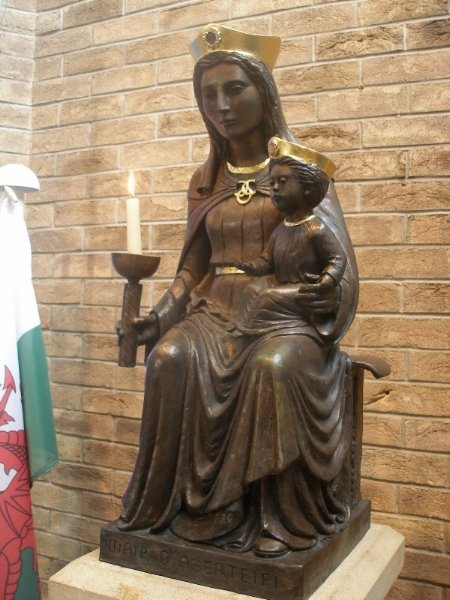Cardigan, Wales
Our Lady of the Taper, Our Lady of Cardigan, Mary of Cardigan (Welsh: Mair o Aberteifi)
Original appeared miraculously in 1158, burnt at the stake in 1538. Present ‘reincarnation’ sculpted by Sr. Concordia Scott (1924 – 2014), a Scottish sculptor and Benedictine nun, in 1986, about 3 feet high, bronze. Shrine usually opens daily at 9 a.m. 1 Aberystwyth Road, Cardigan SA43 1LZ
Our Lady of the Taper received the special “honor” of being burnt at the stake in 1538, in Chelsea, London, along with all the other ancient, famous Madonnas of Great Britain. As with most of the others, much of their traditions and histories were destroyed along with their shrines and their records. Thomas Cromwell, chief minister of King Henry VIII, was very thorough in his quest to eradicate all Catholic “superstitions”. Therefore we don’t know for certain how many of the burnt statues bore the title of Black Madonnas. But like her sisters listed in this index under England and Wales/United Kingdom, she shares characteristics typical of our Dark Mothers. Actually, this one more so than the others, echoes certain themes from around the world: She was found in nature, accompanied by a miracle, brought into a local church, but mysteriously kept returning to the place of her finding, until her children understood that she wanted a special shrine built for her in a natural setting. Many Spanish, French, Italian, and Latin American Black Madonnas tell this same story.
The legend of this Welsh Lady recounts how she appeared on the banks of the River Teifi in Cardiganshire in 1158 with a burning taper in her hand. She was a simple, yet beautiful statue and her shrine immediately became a place of pilgrimage for all of Wales. That original church, St. Mary’s, still stands, though the nave was rebuilt in the 14th century.
St. Mary's Anglican church
The best historical record of this Madonna’s cult stems from the hand of Bishop Barlow, the man charged with destroying it. He writes: "the image now situated in the church of Cardigan which is used for a great pilgrimage to this present day was found standing upon the river Teifi and her son upon her lap and the same taper burning in her hand. The said image was carried to Christ Church of Cardigan and the image would not tarry there but was found three or four times in the place where is now built the Church of Our Lady, and the taper burning in her hand which continued burning the space of nine years without wasting,¹ until the time when it extinguished and never burnt again. … Said taper was then enclosed (in a case) and regarded as a great relic, worshipped, kissed by pilgrims, and sworn upon by men in difficult and hard matters.”² Pilgrims also used to take any wax drippings of the sacred taper they could get their hands on, touch cloth to the statue and taper to soak up the sacred energy of these holy objects and buy wax castings (most likely of the Madonna).³
Our Lady of the Taper Catholic shrine, photo: Martin Crampin
The website Catholic Traditions gives the following account of an ancient ritual that used to be performed at this Lady’s shrine: “At cock-crow a woman will descend from the vault of the choir; bearing a taper which she must present to the Bishop. When he has received it, he must drop some of the wax into jars of water; which he will then give to the sick, and they shall be cured.”
Father Jason Jones, priest and recotor of the shrine of Our Lady of the Taper in 2010, explains the meaning of the taper (candle):“Popular piety associates the image with the Feast of the Presentation of the Lord, Candlemas. … Our Lady is the one who fully reflects the light of her glorified Son and she embraces each pilgrim in the warmth of her love.”⁴
In 1912, exiled French monks from Brittany tried to revive the devotion to Our Lady of the Taper, but it didn’t take quite yet. With the outbreak of WWI, they were conscripted into the army, the church was closed and the devotion lapsed.⁵
In 1952, Bishop Petit learned that there had once been a shrine in Cardigan and decided to restore it. He commissioned a new statue, which was blessed in Westminster Cathedral in 1956 and placed into Our Lady of Sorrows church. Fourteen years later, a new church, Our Lady of the Taper, was consecrated, and the statue placed in its current home. Unfortunately the statue wore badly, and in 1986 a new statue – in bronze – was installed in the Church on Pentecost Sunday in the presence of 4500 pilgrims. It was blessed in Cardiff Metropolitan Cathedral, and like its predecessor, it toured throughout Wales before being placed in the current Church.
The Shrine Church of Our Lady of the Taper was designated as the Welsh National Shrine of Our Lady by Pope Saint John Paul II in 1986. Interesting how the modern shrine didn’t gain real importance until its Madonna was dark and in her own, special church, which echoes the theme of light and darkness of the Black Madonna with the taper! I wonder who was behind that?! ;-)





